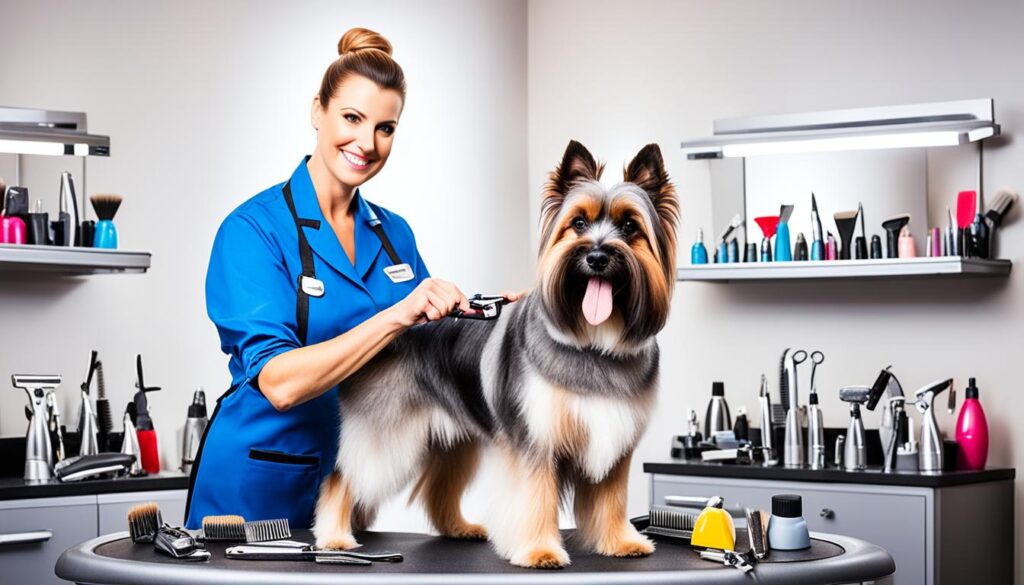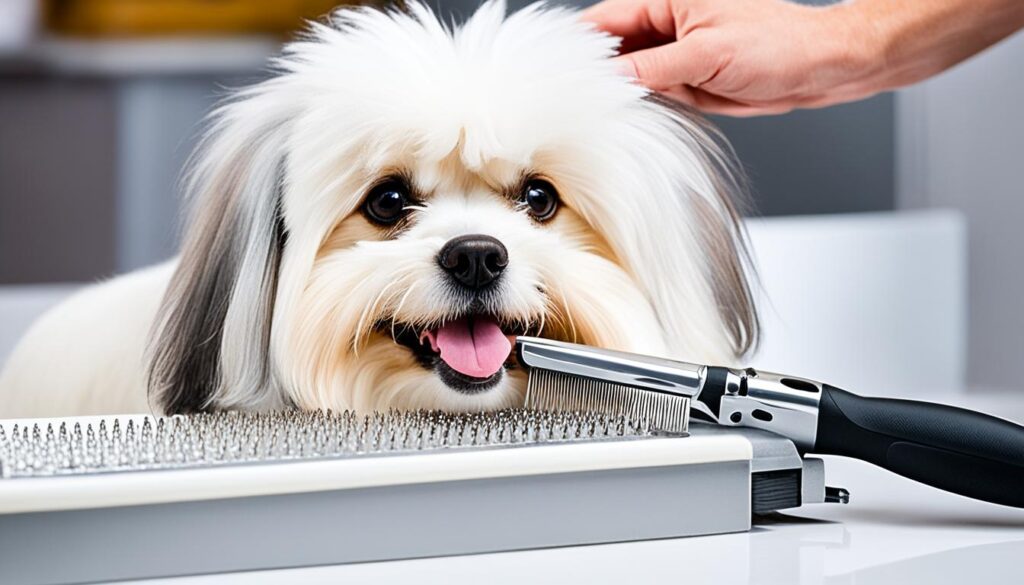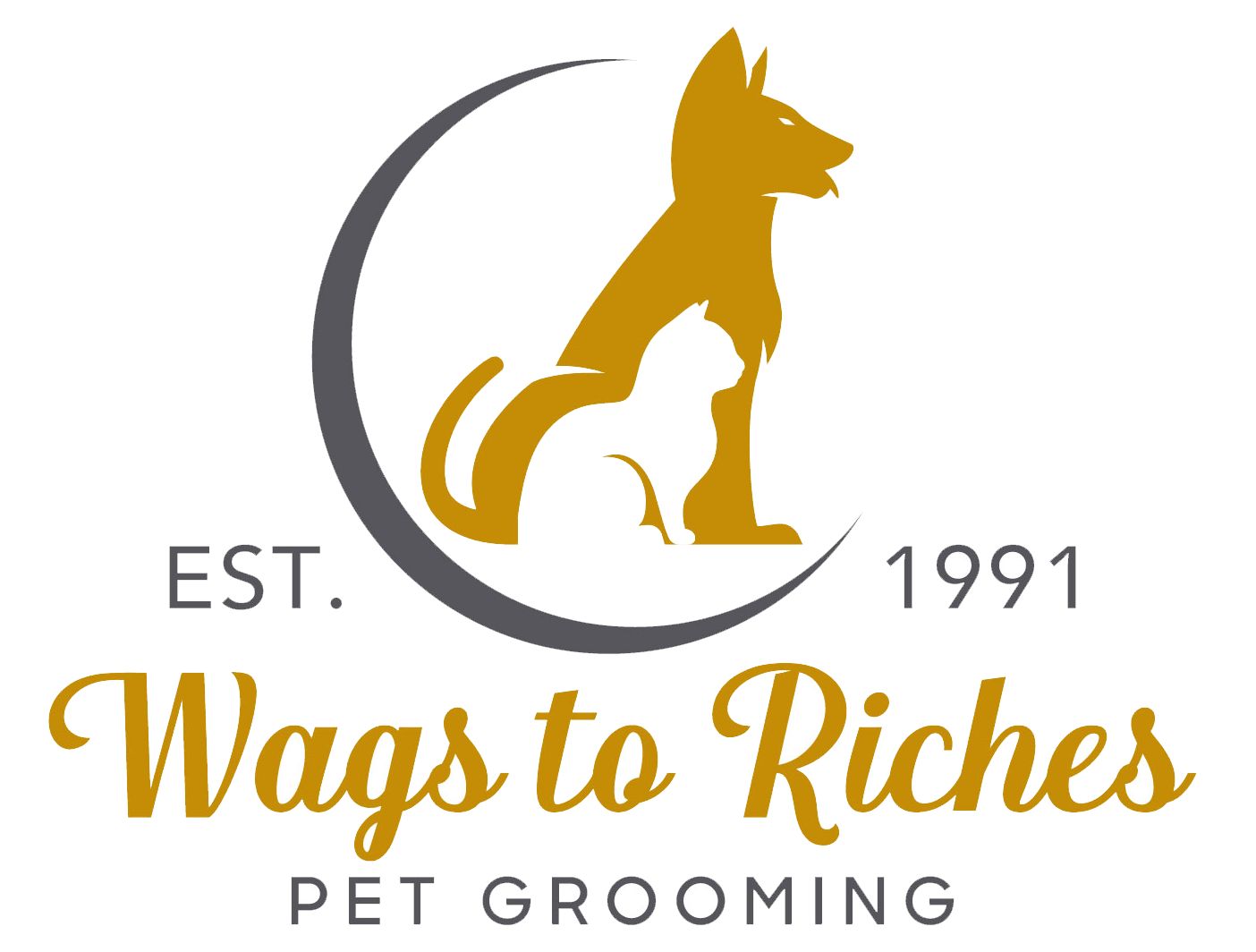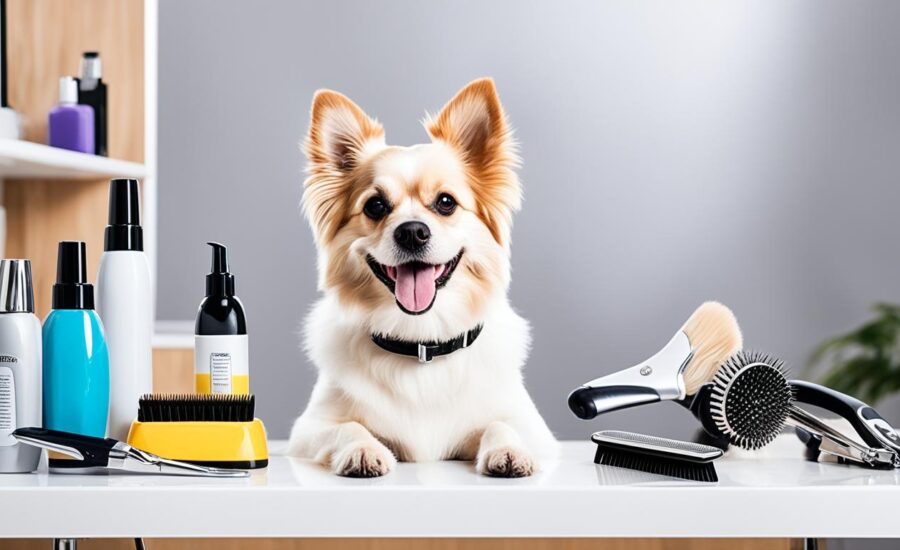Many think dog grooming is just for show. But what if we told you it’s key for your pet’s health and joy? Dog Grooming Essentials go beyond just looking good. They’re important for their lifestyle, safety, and your relationship. Whether you have fancy grooming tools or are just learning, a grooming routine at home can stop many health problems. It also helps keep their coat in great shape.
Grooming is more than making your dog look nice. It’s also about avoiding extra vet visits. Knowing how to groom your dog can save you money and keep them healthy. A good grooming routine will improve your dog’s life quality significantly.
Key Takeaways
- Understanding that dog grooming is an essential aspect of pet health, not just aesthetics.
- Discovering that regular grooming saves on healthcare costs and catches potential health issues early.
- Learning that every breed has different grooming needs and how to assess your dog’s specific requirements.
- Realizing the importance of having the appropriate grooming supplies for dogs and how to use them.
- Finding out that a regular grooming routine extends beyond a good bath, including dental, ear, and nail care.
- Recognizing the connection between good canine coat care and overall happiness and health in dogs.
- Appreciating the impact of at-home grooming on strengthening the pet-owner bond.
Understanding Your Dog’s Grooming Needs
When you Assess Your Dog’s Needs, it’s important to understand that dog grooming varies with the breed. A detailed Breed Coat Breakdown is essential. It helps know how often and what kind of grooming your pet needs. We’ll share dog grooming tips specific to your dog’s coat.
| Breed Type | Coat Characteristic | Grooming Needs |
|---|---|---|
| Smooth Coat | Short and sleek | Regular brushing and occasional baths |
| Wiry Coat | Coarse and rough | Frequent washing and brushing |
| Curly Coat | Dense and curly | Daily detangling to prevent mats |
| Medium Coat | Not too long or short | Balance of brushing and bathing |
| Long Coat | Flowing and lengthy | Extensive grooming to avoid tangling |
Knowing these details helps pet owners meet their dog’s specific needs. For example, a Beagle needs less grooming than a Poodle. No matter the breed, regular grooming is key. Tasks like daily brushing and checking ears and teeth are vital. This makes grooming your dog at home easier and more pleasant.
Investing in the Right Grooming Tools
Keeping your pet happy and healthy means getting the right pet grooming tools. These tools are key for your dog’s hygiene and looks. Starting with the best gear that fits your pet’s needs is important. We will talk about must-have tools and help you pick the right ones for your pet’s grooming.
Choosing the Best Brushes and Combs
The brush is a basic grooming supply for dogs. The kind of coat your dog has tells you what brush or comb to use. Short-haired pets need a firm brush or a comb with wide spaces to clear out loose hair and dirt. Long-haired dogs do well with softer brushes that untangle hair smoothly. It makes grooming nice for your dog and keeps their coat shiny and strong.
Nail Trimming Equipment
Nail care is crucial but often forgotten in pet grooming. The right nail trimmers keep nails short, preventing pain and splitting. Use dog nail clippers or grinders for safe, accurate cuts. Pick sharp tools meant for your pet’s size for healthy paws.

Scissors and Clippers for Different Coat Types
Proper scissors and clippers are vital whether trimming shaggy hair or doing a full haircut. Choose sharp scissors and comfortable clippers suited to your dog’s fur. Heavier coats need tough clippers, while thin coats are okay with simpler tools. The correct grooming products for dogs give your pet a neat look and keep them safe and comfy during grooming.
Bathing Supplies
Bathing is key in dog grooming, and the right products make it easier. Pick shampoos and conditioners made for dogs. You’ll also need soft towels and a slip-proof mat. Having a special spot for baths makes it less stressful. Make sure you have all needed grooming supplies for dogs to make bath time easy.
| Tool Type | Use | Recommended for Coat Type |
|---|---|---|
| Brushes and Combs | Detangling, smoothing, removing loose fur | Short to long coats; specific type dependent on fur texture and length |
| Nail Clippers/Grinders | Trimming and maintaining nail health | All breeds and sizes |
| Scissors/Clippers | Coat trimming and styling | Thicker coats may require more robust clippers; thinner coats can use standard scissors |
| Bathing Supplies | Cleaning and conditioning | All breeds; products vary based on skin sensitivity and coat needs |
With these professional dog grooming tips and top grooming products for dogs, you’re ready to take care of your pet’s grooming at home.
Maintaining a Routine: Bathing and Coat Care
For a happy and healthy dog, it’s key to keep up a regular canine coat care routine. This is just as crucial as their daily walks. Knowing the right dog grooming techniques turns what could be a chore into fun bonding time. These moments are full of benefits for both of you.
Proper Bathing Techniques
Bathing is a big part of grooming your dog at home. Always use lukewarm water and dog-specific shampoos for safety and effectiveness. Start by making sure the coat is fully wet. Then, gently massage in the shampoo and rinse well to avoid irritation. Finish with a towel dry or use a blow dryer on a cool setting to get them fully dry.
Brushing Strategies for Different Coats
Different coats need different brushing methods. For short-haired dogs, a weekly brushing helps remove loose fur and keeps their skin healthy. In contrast, long-haired or double-coated dogs may require daily brushing. This prevents tangles and spreads natural oils. Regular brushing is vital for canine coat care. It lets you spot any changes in their skin or coat health.
Dealing with Matts and Tangles
Handling matts and tangles means being patient and having the right tools. Start with a detangling spray or conditioner to ease the knots. Use a wide-tooth comb or dematting tool, working from the ends to the skin gently. If the mats are too stubborn, consider a professional groomer to prevent skin damage.

Grooming your dog at home is not just about looks. It’s part of their overall care that affects their comfort and health. Regular checks for parasites, skin problems, and other issues are essential. Sticking to these dog grooming tips keeps your furry friend joyful, comfy, and healthy.
| Coat Type | Brushing Frequency | Bathing Routine | Additional Care Notes |
|---|---|---|---|
| Short-haired | Once a week | Monthly | Minimal undercoat; low risk of matting |
| Long-haired | Daily | Every 4-6 weeks | Prone to tangles; check for mats regularly |
| Double-coated | 2-3 times a week | Seasonal adjustments | Extra brushing during shedding seasons |
| Curly/wiry | Several times a week | Every 4-8 weeks | Professional grooming recommended for cutting |
Essential Grooming Tasks Beyond Bathing
Beyond the basics of bathing, a dog’s health involves more. This includes teeth care, ear cleaning, and nail trimming. All are key for your pet’s well-being. It’s important to use the right pet grooming tools. Especially for the sensitive parts like ears and teeth. Dog owners should talk to vets to find the best grooming products for dogs. This might mean getting special toothbrushes or dental care products to keep teeth clean and breath fresh.
Cleaning a dog’s ears needs care and the right grooming supplies for dogs. Soft materials and gentle cleaners are best to avoid hurting sensitive ears. Cutting nails regularly is also crucial. It helps your dog walk comfortably without any pain. Use proper nail clippers or grinders. This makes trimming quick and stress-free, keeping your dog at ease.
Having the best grooming supplies for dogs makes these tasks easier. This ensures your dog stays healthy and happy. And you’ll feel good knowing you’re taking great care of them. Grooming is one way to show your love for your furry friend.
FAQ
How often should I groom my dog?
How do I determine what my dog’s grooming needs are?
What type of brush is best for my dog’s coat?
How do I properly trim my dog’s nails?
Which scissors or clippers are suitable for my dog’s coat type?
What do I need to bathe my dog properly?
What is the best way to bath my dog, and how often?
How should I brush my dog’s coat?
How can I deal with mats and tangles in my dog’s fur?
What other grooming tasks should I consider beyond bathing?
Source Links
- https://www.24petwatch.com/ca/blog/guide-to-grooming-your-dog
- https://www.animalbehaviorcollege.com/blog/animal-career-advice/grooming/the-ultimate-guide-to-dog-grooming-tips-tricks/
- https://www.caninemaster.com/blog/the-essential-dog-grooming-guide

